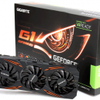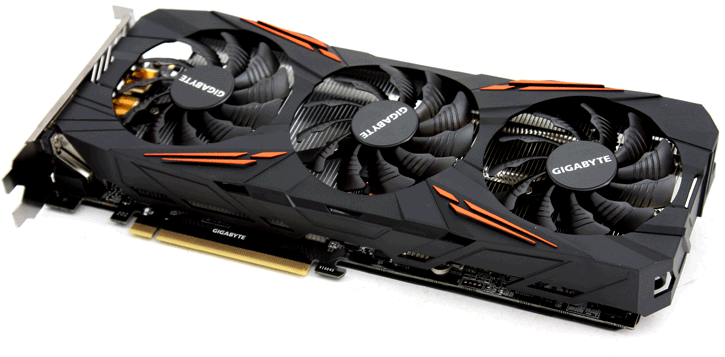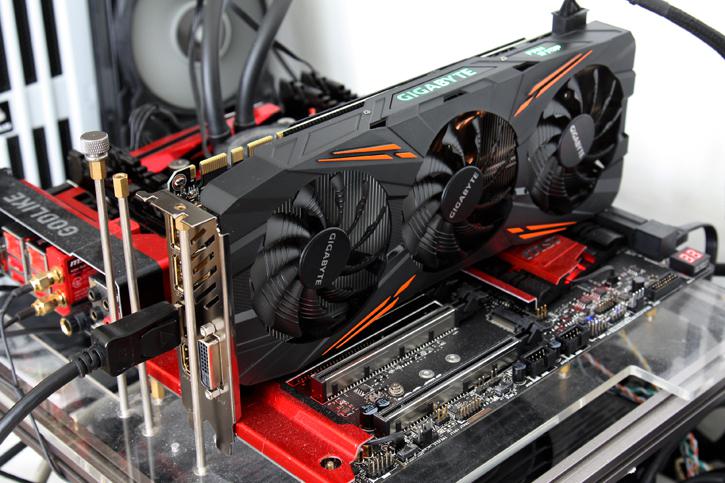Conclusion
Conclusion
The new Pascal GPU based products from Nvidia are a bit of a hit, and while I do think the GeForce GTX 1070 is going to be the more popular product over the 1080 due to pricing, there obviously will be many 1080 aficionados out there as well. Fur the guys and girls that do want to go all in there will be plenty to choose from. And sure, gigabyte has a lovely offering with this G1 GAMING edition graphics card. It performs _really_ nice, has a bit a of tweaking left in it as well as already being factory overclocked. Next to that the 8GB is lovely to have and kind of makes you futre proof. Next to the terrific looks and all factors combined, you will easily be impressed once this bad boy sits resides inside that PC of yours.
Initially the 1080 was supposed to replace the GTX 980, but 16nm treated Nvidia really well and they are able to run high clock frequencies at low voltage levels, and that resulted into that little extra. As such the 1080 is faster compared to a the 980 Ti and Titan X. You are looking at 20% to 40% performance increases depending on game title and resolution, yeah that is not a bad position to be in and as such Nvidia advances a nice step forward. I also need to applaud the step of moving towards 8 GB of graphics memory. Whilst the highest used we ever measured is in the 5 to 6 GB VRAM domain, that 8 GB 256-bit GDDR5X memory is an excellent and well-balanced amount of graphics memory. But hey, who knows with titles like The Division / GTA5 and technologies like Ultra HD and / or DSR versus performance and VRAM what you find valid, or not. High up there in the enthusiast space there certainly is a market for cards like these. That makes these 8 GB models relevant for gaming.
Aesthetics
Gigabyte tweaked the design and looks a bit for the new WindForce 3X model cooler, combined with its black design and orange striping it certainly looks totally bad-ass. As any manufacturer will do, the product also comes with RGB LED lighting control. Switch it on/off or to any color and animation you prefer, the choice is yours. Cool dibs is that backplate, however it lacks openings at the proper areas (GPU/VRM) for venting. As you can see, I remain skeptical about backplates, they potentially can trap heat and thus warm up the PCB. The WindForce 3X reached 73 Degrees C with three fans, we do wonder if that number could have been a notch lower if that backplate wasn't closed completely. Granted, 73 Degrees C is still lovely and below the reference / founders products. Backplates do look much better, make the PCB more sturdy (bends less or not at all) and can protect your PCB and components from damage. Consumer demand is always decisive, and you guys clearly like graphics cards with backplates.
Cooling & Noise Levels
The reference design (founder editions) of the GTX 1080 are set at an offset threshold of 80 degrees C. Once the GPU gets warmer the card will clock down / lower its voltage etc to try and keep the card cooler, that's throttling and it part of the design. Gigabyte however throws in a cooler that manages roughly 500 to 600W of cooling performance. It is a good one, so good that up-to a degree or 60 on the GPU, this card remains passive and thus inaudible. Once the fans kick in, you can expect to hover at the 70~73 Degrees C marker, with seriously demanding games. Please do note that you will need proper ventilation inside your chassis to achieve that number as most heat is vented inside your chassis. But Gigabyte shaved off a good 7 to 10 Degrees C over reference (founders). Noise wise, we can’t complain about cooling whatsoever however once you pass 71 Degrees you will be able to hear the fans. Once overclocked with added voltage we always do recommend a little more fan RPM, this does increase noise a tiny bit, but it's nothing dramatic by any standard. We heard a tiny bit of coil-noise, nothing dramatic. In fact housed inside a closed chassis we doubt you would ever notice it.
Power Consumption
Any GP104 Pascal GPU and thus GP104 based graphics card is rated as having a 180 Watt TDP under full stress, our measurements back that up albeit a notch higher due to the faster clocks and thus voltage usage. Anyhow, at this performance level you are looking at a card that consumes roughly 400~450 Watts for a stressed PC in total, that is okay. We think a 500~600 Watt PSU would be sufficient and if you go with 2-way SLI say an 750 Watt power supply is recommended. It's definitely more than needed but remember - when purchasing a PSU, aim to double up in Wattage as your PSU is most efficient when it is under 50% load. Here again keep in mind we measure peak power consumption, the average power consumption is a good notch lower depending on GPU utilization. Also, if you plan to overclock the CPU/memory and/or GPU with added voltage, please do purchase a power supply with enough reserve. People often underestimate it, but if you tweak all three aforementioned variables, you can easily add 200 Watts to your peak power consumption budget as increasing voltages and clocks increases your power consumption.
Overall gaming performance
Do you really need a card as beefy as the GeForce GTX 1080 really is though? Well, that depends on a rather abstract external factor, your monitor(s) and in specific the resolution you play your games at. If you game at a resolution of 1920x1080 (Full HD) then no, not really. However, more is better and with technologies like DSR (super-sampling) and Ultra HD the raw horsepower this card offers certainly isn't distasteful. Also, with with surround gaming (three monitors) the GeForce GTX 1080 will just make a lot of sense, especially with the new simultaneous multi-projection feature build into the rendering pipeline, that probably is one of the most innovative features Nvidia has added that I have seen in a long time. From 1080p to Ultra HD the GeForce GTX 1080 hauls the proverbial toosh compared to whatever other single GPU based graphics card you can name in existence. Obviously it is the fastest kid on the block. This much performance and graphics memory helps you in Ultra HD, hefty complex anti-aliasing modes, DSR and of course the latest gaming titles. I consider this to be among the first viable single GPU solutions that allows you to game properly in Ultra HD with some very nice eye candy enabled. However, I was kinda hoping to be closer to 60 FPS on average with the GTX 1080 in Ultra HD. But that will probably take the future Big Pascal (Ti / Titan). As always, drivers wise we can't complain at all, we did not stumble into any issues. And with a single GPU there's no micro-stuttering and no multi-GPU driver issues to fight off. Performance wise, really there's not one game that won't run seriously good at the very best image quality settings. Gaming you must do with a nice 30" monitor of course, at 2560x1440/1600 or Ultra HD. Now, we can discuss the advantages of an 8 GB framebuffer, but hey, you can draw your own conclusions there. At least you won't run out of graphics memory for the years to come right? So in that respect the card is rather future proof. SLI then, we have to mention this. Starting with Pascal the primary focus for Nvidia in terms of multi-GPU setups is that they will support 2-way SLI, but really that's it and all. For those of you that want to run 3 and 4-way configuration, unless you want to breach 3Dmark records, it's not going to do anything for you int erms of value. Do not expect Nvidia to enhance drivers for it.
Once last remark on performance. You will have noticed that in some games this higher clocked product is a good 10% faster where in other just a few percent. That's Nvidia's limiters at work for you. All card under very hefty load will be limited in a way more narrow bracket. Whereas games that leave enough breathing room can advance on that GPU and score better opposed to some other games.
Overclocking
Due to the many limiters and hardware protections Nvidia has built in all and any cards will hover roughly at or just over the 2 GHz on the Boost marker. That frequency will differ per game/application. On 3DMark Firestrike for example it may hover at ~2000 MHz, while in Rise of the Tomb Raider (2016) you will be closer towards 2.1 GHz. The reality is that Nvidia monitors and adapts to hardware specific loads, e.g. an application that is nearly viral like on the GPU will have the effect of the GPU protecting itself by lowering clocks and voltages. The opposite applies here as well, if a game does not try & fry that GPU, it'll clock a bit faster within the tweaked thresholds at your disposal. Tweaking is fun, but definitely more complicated anno 2016. The memory can reach 11 Gbps effectively, I have seen some card even reach 1.2 GHz/Gbps. Pascal GPUs do like their memory bandwidth though, so if you can find a high enough stable tweak, definitely go or it if you are seeking that last bit of extra performance. For the G1 Gaming we reached a stable 2088 MHz on the boost frequency and a terrific effective data-rate) of 11404 MHz on the memory.
Concluding
Gigabyte offers an incredibly attractive looking and performing product with that all new G1 Gaming. With that 8 GB of GDDR5X memory you will purchase a product that is future proof for a while (although in the world of technology that I am afraid is a relative statement). The g1 Gaming is fresh and exciting and though it sits in a rather high price bracket, it's hard to not dislike it. The GTX 1080 G1 gaming will bring a truckload of gaming performance towards your PC, and combined with little extra boom-boom-pow from Gigabyte it has been improved to an even better level. The new Pascal architecture proves its agility and the die shrink to 16 nm FiNFET shows low power consumption due to lower voltages and obviously the high clock-speeds and that GDDR5X memory offer the complete package that the GTX 1080 is. If you stick to the WHQD 2560x1440 domain this is the card that will last you years to come combined with that lovely 8 GB of graphics memory. For long-term Ultra HD usage (high FPS / GPU demanding titles) however the answer still needs to be found in two cards. But hey, if WHQD is your domain then the GeForce GTX 1080 is a rather future proof product with that proper and fast 8GB GDDR5X graphics memory. The Gigabyte GeForce GTX 1080 G1 GAMING comes factory tweaked stiaght out of the box for you, it remains a relatively mild tweak but does not shy away from the fact that it'll bring in an extra bunp upwards in your framerate. The few remarks really I can think of is that the G1 Gaming is not 100% silent, under full load and higher then 70C temperatures you will hear the fans slightly. But let me emphasize, nothing dramatic, it's just a bit of fan noise that in fact might even be tweaked out with a BIOS update as the cooler definitely has enough room for tweaking. Secondly, I simply am not a fan of closed rear side backplates.
The G1 gaming is a pretty raw and brutal product in game performance a very good looking product. I still say that the 1070 cards are going to be the biggest hit of the Summer of 2016, but for those with a bigger wallet the Gigabyte GeForce GTX 1080 G1 GAMING certainly is hit product that we will recommend.
Other Related reviews
- Gigabyte GeForce GTX 1080 G1 Gaming 8GD review
- MSI GeForce GTX 1080 GAMING X 8G review
- MSI GeForce GTX 1070 GAMING X 8G review
- GeForce GTX 1080 Founders reference review
- GeForce GTX 1080 FCAT Frametime Analysis
- GeForce GTX 1080 Overclock guide
- GeForce GTX 1070 Founders reference review
- GeForce GTX 1070 FCAT Frametime Analysis
Recommended Downloads
- Sign up to receive a notice when we publish a new article
- Or go back to Guru3D's front page




